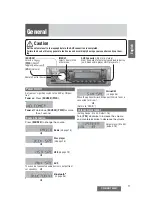
Xtium2-CLHS PX8 User's Manual
Technical Specifications
•
75
Connecting to Dual Output CLHS Camera
Distributed processing of high bandwidth image data generated by Dual Output CLHS camera is
easily configured by connecting the camera to multiple Xtium2-CLHS boards. The following
description and block diagram shows the simple physical setup. The user has total control to the
actual distributed processing task divisions and algorithms.
of the first Xtium2-CLHS board installed in the first PC. This
board is defined as the “Master Frame Grabber”.
Using a second Camera Link HS cable, connect camera output #2 to
CLHS board installed in a separate computer or the same as the first Xtium2 if it can manage
the processing. This second board is defined as the “Camera Slave Port Frame Grabber”.
The Camera Slave Port Frame Grabber must set
CORACQ_VAL_CLHS_CONFIGURATION_CAM_PORT_SLAVE in the parameter
CORACQ_PRM_CLHS_CONFIGURATION in order to configure the frame grabber as the one
connected to a camera slave port. In this mode, camera controls are written via the Camera
Master Port Frame Grabber only.
Control of the data portion transferred on each camera output is controlled by the camera.
The use of the CORACQ_PRM_DATA_VALID parameter can be used in order for all frame
grabbers to acquire the same triggered frames and/or lines. Once the
CORACQ_PRM_DATA_VALID is enabled on the master frame grabber, a data valid signal is
initiated by the master frame grabber through the camera trigger message. The camera will
then pass the data valid control in the video packets. On Camera Slave Port Frame Grabbers
that also have the data valid enabled, only the video packets that have the data valid control
enabled will be acquired.
CLHS
High Bandwidth
Camera
Xtium-CLHS
#1
J3
J2
Xtium-CLHS
#2
J3
J2
CLHS Cable
CLHS Cable
Master
Frame
Grabber
Camera Slave
Port Frame
Grabber
Figure 22: Dual Camera Output Connection Block Diagram















































